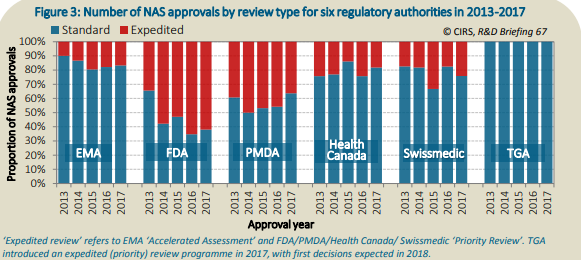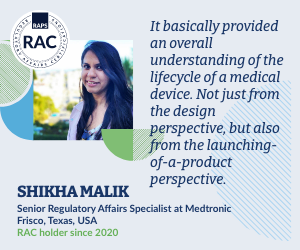FDA Faster Than Global Peers at Approving New Drugs
![]() Regulatory News | 16 May 2018 |
Regulatory News | 16 May 2018 |
A report from the Centre for Innovation in Regulatory Science (CIRS) released this month finds that the US Food and Drug Administration (FDA) has reclaimed its position as the fastest major regulator for approving new drugs and biologics.
According to the report, FDA spent a median 243 days to approve products with a new active substance (NAS) in 2017, 90 days faster than its closest peer, Japan's Pharmaceuticals and Medical Devices Agency (PMDA), which took a median 333 days.

While FDA has typically taken less time to approve NASs than other prominent regulators over the last decade, efforts by Japan to speed drug evaluations led PMDA to edge FDA out for quickest reviews from 2014-2016.
After FDA and PMDA, Health Canada was the third quickest to approve NASs, followed by TGA, EMA and Swissmedic, with review times on par with their respective 2015-2016 levels.
In addition to approving NASs quicker than other regulators, FDA also approved more NASs than its peers, with 50 (CIRS' count includes biologics reviewed by FDA's Center for Biologics Evaluation and Research) NASs approved, compared to 30 approved by EMA and Health Canada, 29 by Swissmedic, 24 by TGA and 22 by PMDA.
FDA also approved most (86%) of those products before or within one month of its peers at other agencies.
The increased use of expedited review pathways contributed significantly to FDA's ability to quickly review submissions. In 2017, 62% of NASs approved by FDA were given priority reviews and 40% were granted breakthrough therapy designation. While all six regulators offer expedited review pathways for certain products, FDA utilized these pathways for a higher proportion of its reviews.

However, while FDA was faster than its peers overall, both EMA and Health Canada were quicker than FDA at reviewing products with expedited reviews, with EMA taking a median 235 days to approve products with an accelerated assessment and Health Canada taking a median 209 days to approve products with a priority review.
The report also finds that more NASs are being approved across all six agencies than in the past, with 51 NASs being approved across the agencies from 2013-2017, compared to just 12 NASs from 2008-2012.
But while submissions to FDA and EMA occurred around the same time for most products, the report still found an 80- to 100-day submission gap between the two agencies and the other four regulators.
CIRS
According to the report, FDA spent a median 243 days to approve products with a new active substance (NAS) in 2017, 90 days faster than its closest peer, Japan's Pharmaceuticals and Medical Devices Agency (PMDA), which took a median 333 days.

While FDA has typically taken less time to approve NASs than other prominent regulators over the last decade, efforts by Japan to speed drug evaluations led PMDA to edge FDA out for quickest reviews from 2014-2016.
After FDA and PMDA, Health Canada was the third quickest to approve NASs, followed by TGA, EMA and Swissmedic, with review times on par with their respective 2015-2016 levels.
In addition to approving NASs quicker than other regulators, FDA also approved more NASs than its peers, with 50 (CIRS' count includes biologics reviewed by FDA's Center for Biologics Evaluation and Research) NASs approved, compared to 30 approved by EMA and Health Canada, 29 by Swissmedic, 24 by TGA and 22 by PMDA.
FDA also approved most (86%) of those products before or within one month of its peers at other agencies.
The increased use of expedited review pathways contributed significantly to FDA's ability to quickly review submissions. In 2017, 62% of NASs approved by FDA were given priority reviews and 40% were granted breakthrough therapy designation. While all six regulators offer expedited review pathways for certain products, FDA utilized these pathways for a higher proportion of its reviews.

However, while FDA was faster than its peers overall, both EMA and Health Canada were quicker than FDA at reviewing products with expedited reviews, with EMA taking a median 235 days to approve products with an accelerated assessment and Health Canada taking a median 209 days to approve products with a priority review.
The report also finds that more NASs are being approved across all six agencies than in the past, with 51 NASs being approved across the agencies from 2013-2017, compared to just 12 NASs from 2008-2012.
But while submissions to FDA and EMA occurred around the same time for most products, the report still found an 80- to 100-day submission gap between the two agencies and the other four regulators.
CIRS
© 2025 Regulatory Affairs Professionals Society.












